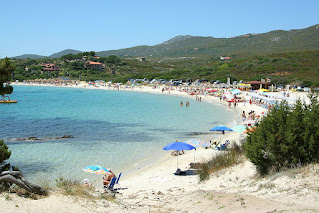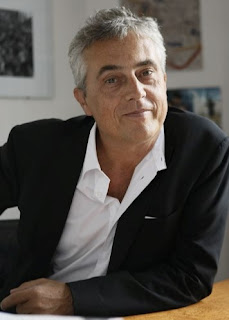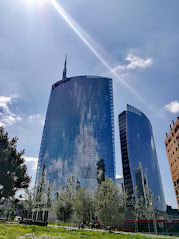Key designer in Costa Smeralda project
 |
| The church of Stella Maris in Porto Cervo has the soft lines typical of Michele Busiri Vici's style |
Along with the French architect Jacques Couelle and his fellow Italian, Luigi Vietti, Vici was commissioned by the Aga Khan, Prince Shah Karim al-Husseini, to develop the area at the northeastern tip of the island and build a new resort, Porto Cervo.
The prince, himself said to be worth $13.3 billion as one of the world’s richest royals, assembled a consortium of investors to finance the project, which began in 1961 and remains a destination popular with celebrities, business and political leaders and other wealthy individuals.
Vici’s contributions included the highly distinctive church of Stella Maris in Porto Cervo, the Hotel Romazzino and Hotel Lucia della Muntagna and numerous villas.
He also left his mark on Porto Rafael, a small resort founded by another wealthy individual, Raphael Neville, Count of Berlanga de Duero, in the late 1950s. There he designed the Piazzetta, a chapel, and private villas for clients such as Peter Ward, a brother of the Earl of Dudley, and the Guinness heiress Maureen Dufferin, who was a cousin of the Aga Khan.
.jpg) |
| Vici was engaged by the Aga Khan |
On the French side of the dynasty was Jean Beausire, an engineer and fountain maker who was chief of public works in Paris for Kings Louis XIV and Louis XV of France between 1684 and 1740. On the Italian side, Andrea Vici (1743–1817) worked under Luigi Vanvitelli on the Royal Palace of Caserta near Naples and later on projects for the Vatican.
Michele’s older brother, Clemente Busiri Vici, designed churches for Pope Pius XI, such as Gran Madre di Dio and San Roberto Bellarmino, on which another brother, Andrea, also worked.
Michele Busiri Vici graduated in 1921 from the Rome School of Engineering. At first, he worked with his brother Clemente, working on projects such as a castle for the Gaulino family in Sestri Levante in Liguria and a villa-museum for the Gaulino family in Turin, now a prestigious hotel.
In 1930, branching out on his own, he created the Villa Attolico near Porta Latina in Rome, restored the Castle of Torre in Pietra and designed gardens around the archaeological site of Ostia Antica.
 |
| A villa in the Costa Smeralda designed by Michele Busiri Vici, valued at around €14 million (£11.76m) |
With soft lines, whitewashed walls and fixtures painted in the colour now known as 'Busiris Green', these villas in what became known as the Mediterranean style were his trademark, although he regularly worked on other projects to ensure he was not pigeonholed as simply a designer of coastal villas.
These included the interior of the turbine steamship Raphael for the Italian Navigation Company, and urban projects that contributed to the redevelopment of Athens and Rome. In the Italian capital, his distinctive designs still stand out in the Via Vigna Stelluti, Ponte Milvio and Parioli areas.
In his work on the Costa Smeralda, the soft lines and whitewashed walls of his villas around Sabaudia were embellished with terracotta tiles and ceramics and even incorporated the huge, granite boulders that were a common feature of the handscape.
Busiri Vici retired in 1977 and died in Rome four years later, aged 86. His grandson, also named Michele Busiri Vici, followed him into architecture. He is principal and founder of Space4Architecture (S4A), based in New York.
 |
| The Costa Smeralda is famed for its miles of white, sandy beaches in northern Sardinia |
Originally the name of a small stretch of coastline near the town of Arzachena in northern Sardinia, the Costa Smeralda, known in Sardinian dialect as Montes de Mola, now incorporates some 20km (12 miles) of white sand beaches, lined with golf clubs and exclusive hotels and has become one of the most expensive locations in Europe in terms of property prices, with houses costing up to €330,000 ($348,000; £252,000) per square metre. In addition to Porto Cervo, the main towns are Liscia di Vacca, Capriccioli, and Romazzino. Each September, the Sardinia Cup sailing regatta is held off the coast, while wealthy residents and visitors can take mark in polo matches at Gershan. near Arzachena. The area is rich in archaeological sites from the Nuragic period, which lasted about 1,500 years from the Bronze Age until the Roman colonisation of the island in 238 BC.
 |
| The Piazzetta in Porto Rafael, which was designed by Michele Busiri Vici |
Porto Rafael was founded by Raphael Neville, Count of Berlanga de Duero, in the late 1950s. Neville was the son of Edgar Neville, the Hollywood film director, who inherited his title from his maternal family, who were Spanish aristocrats. Although he defied his father’s wish that he study architecture at college in favour of a more bohemian lifestyle, after buying an area of land by the sea near the town of Palau, he had enough interest in the subject to draw the design for a port. Over time, with the encouragement of friends, the financial support of contacts and the work of architects such as Michele Busiri Vici, the port was built and well-heeled buyers began to acquire plots of land to build villas. The attraction for them was that, unlike the flashier Porto Cervo, there was no tourist hotel and therefore no crowds. Even today, Porto Rafael, though it has a yacht club, boasts only a limited number of shops.
Also on this day:
1660: The birth of composer Alessandro Scarlatti
1913: The birth of car designer Pietro Frua
1930: The birth of campaigning politician Marco Pannella




